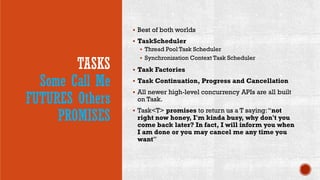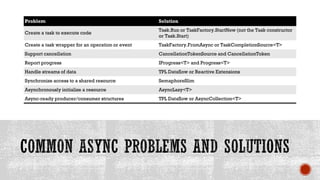Asynchronous programming - .NET Way
- 1. .NET WAY
- 2. ASYNCHRONY I Am Bit Tricky To Catch Trendy Examples: AJAX, AMD etc. and numerous language- level/addon implementations Languages supporting async patterns: C#:Tasks, Java7-8: Future and CompletableFuture Go: Routines and channels, Erlang: Processes and spawn Python: tasks, coroutines (asyncio) JavaScript (ES2017-ES8): Promises and list goes on.
- 3. ASYNCHRONY I'll Call You Back Occurrence of events independent of the main program flow Enables this “main program” continue its work, not blocking to wait for event results Implicit degree of parallelism
- 4. BENEFITS I Am Not Just For UI Apps 1. Scalability and 2. Offloading (e.g. responsiveness, parallelism) Most client apps care about asynchrony for “Offloading” reasons For store, desktop and phone apps: primary benefit is responsiveness Most server apps care about asynchrony for “Scalability” reasons Node.js, ASP.NET Core are inherently asynchronous, hence scaling is their key. Common Question: Does async have a place on the server?
- 5. GOAL I Am About To Discussed More? History of Asynchronous APIs on .NET Thread,Threadpool and Task Conceptual overview of request handling on ASP.NET I won’t be covering C# async-await API syntax
- 6. HISTORY .Net And .Net Languages have Always Been Loving Async APM (.NET1.1) : Socket class Begin<MethodName> and End<MethodName> methods EAP (.NET2) : e.g. BackgroundWorker class <MethodName>Async methods Task and TPL (.NET4) Task-based Asynchronous Pattern (TAP) (.NET4.5) Async and await Language level support on C# and VB (2012), F# (2010) TAP: Recommended asynchronous design pattern
- 7. THREAD I Am An Action Lady First appears in IBM OS/360 in 1967 Its actual OS-level thread Gives life to a process Each process has at least one thread (Main thread) Threads share their address space
- 8. CLR THREAD You should hate new Thread() Freaking expensive: Memory and time overhead associated with them Thread = (Thread Kernel Object) x86-700BYTE, x64-1240BYTE + (Thread Environment Block) x86-4KB, x64-8KB + (User Mode Stack) x86, x64-1MB + (Kernel Mode Stack) x86-12KB, x64-24KB CLR thread directly maps to Windows thread Highest degree of control that programmers don’t want Only spun up new if heavy computations on multiple CPUs needs to be done. Foreground and background threads
- 9. THREADPOOL I manage threads for you, sir! Thread pool is a set of threads available readily and maintained by the CLR. No control but pool size: Submit work to execute, wait for good to happen Best for large no. of short operations where the caller does not need the result.
- 10. CONTINUED… Threadpool size (no. of threads) Default minimum = No. of processors Default maximum = 5000 (.NET4.5) Thread Injection: Starvation avoidance and hill- climbing algorithm Threads are added or removed every 500ms Thread pool categorizes its threads as Worker threads I/O completion port (IOCP) threads
- 11. IIS: REQUEST HANDLING Web Dev? You Need To Understand Me An app/web server Kernel mode and user mode (Native mode) App pool: Grouping of URLs that is routed to one or more worker processes.
- 12. OLD SYNCHRONOUS WAY You Devs Love Me, Don’t You? ASP.NET takes one of its thread pool threads and assigns it to just arrived request Request handler call that external resource synchronously and blocks it until result returns
- 13. BAD PART All Busy,Try Later Thread count saturation Available threads blocked and wasted New request have to wait and in danger of 503
- 14. ASYNCHRONOUS WAY Don’t Trust Me? Try Then Async don’t waste precious threadpool threads Server could cope new request easily Smaller number of threads to handle a larger number of requests.
- 15. THREADPOOL SIZE Just Increase Me And Forget Async Altogether. I Do Joke Too Async does not replace the thread pool, rather makes optimum use of it Scales both further and faster than blocking threadpool threads Less memory pressure Can respond to sudden swings in request volume Common question: What About the Thread Doing the AsynchronousWork? There must something monitoring at it, right? No, not at all
- 16. TASKS Some Call Me FUTURES Others PROMISES Best of both worlds TaskScheduler Thread Pool Task Scheduler Synchronization Context Task Scheduler Task Factories Task Continuation, Progress and Cancellation All newer high-level concurrency APIs are all built on Task. Task<T> promises to return us a T saying:“not right now honey, I'm kinda busy, why don't you come back later? In fact, I will inform you when I am done or you may cancel me any time you want”
- 17. CPU-BOUND TASK I Love CPU, Not You; Leave Me Alone Async Don’ts Too lightweight I/O (<30ms) CPU-Intensive Operations Historic problems with async: Asynchronous code is difficult Database backend is a bottleneck But today ( past few years ) Bottleneck pushed back to app server
- 18. ASP.NET ASYNC PATTERNS Where Were You? As If You Cared? Always There, Just Bit Shy In Asp.Net since very beginning AsynchronousWeb pages introduced in ASP.NET 2.0 MVC got asynchronous controllers in ASP.NET MVC 2 However, always been awkward to write and difficult to maintain Now, the tables have turned In ASP.NET 4.5, async-await is savior More and more companies are embracing async and await on ASP.NET.
- 19. ASYNC FLOW I Yield Control Back To The Caller
- 20. NOT TO CONFUSE WITH TPL We Sound Similar But Inherently Different
- 21. TPL…
- 22. TPL API…
- 24. ASYNC BEST PRACTICES Be Clever Else You Are Busted
- 25. Old New Description task.Wait await task Wait/await for a task to complete task.Result await task Get the result of a completed task Task.WaitAny await Task.WhenAny Wait/await for one of a collection of tasks to complete Task.WaitAll await Task.WhenAll Wait/await for every one of a collection of tasks to complete Thread.Sleep await Task.Delay Wait/await for a period of time Task constructor Task.Run or TaskFactory.StartNew Create a code-based task
- 26. Problem Solution Create a task to execute code Task.Run or TaskFactory.StartNew (not the Task constructor or Task.Start) Create a task wrapper for an operation or event TaskFactory.FromAsync or TaskCompletionSource<T> Support cancellation CancellationTokenSource and CancellationToken Report progress IProgress<T> and Progress<T> Handle streams of data TPL Dataflow or Reactive Extensions Synchronize access to a shared resource SemaphoreSlim Asynchronously initialize a resource AsyncLazy<T> Async-ready producer/consumer structures TPL Dataflow or AsyncCollection<T>
- 27. REENTRANCY Don’t Exploit Me For God Sake Else My Curse Will Hurt You Reentering an asynchronous operation before it has completed Prevent reentrancy or it can cause unexpected results Disable subsequent invokes until its done Cancel and Restart operation Run multiple operations and Queue the output
- 28. FINE TUNING Want Precision And Flexibility To Your Async App? More APIs For You CancellationToken, Task.WhenAll and Task.WhenAny Start multiple tasks and await their completion by monitoring a single task. Use cases: Cancel an Async Task or a List of Tasks Cancel Async Tasks after a Period of Time Cancel Remaining Async Tasks after One Is Complete Start Multiple Async Tasks and Process Them As They Complete
- 31. To understand why asynchronous requests scale, let’s trace a (simplified) example of an asynchronous I/O call. Let’s say a request needs to write to a file.The request thread calls the asynchronous write method.WriteAsync is implemented by the Base Class Library (BCL), and uses completion ports for its asynchronous I/O. So, the WriteAsync call is passed down to the OS as an asynchronous file write.The OS then communicates with the driver stack, passing along the data to write in an I/O request packet (IRP). This is where things get interesting: If a device driver can’t handle an IRP immediately, it must handle it asynchronously. So, the driver tells the disk to start writing and returns a “pending” response to the OS.The OS passes that “pending” response to the BCL, and the BCL returns an incomplete task to the request- handling code.The request-handling code awaits the task, which returns an incomplete task from that method and so on. Finally, the request-handling code ends up returning an incomplete task to ASP.NET, and the request thread is freed to return to the thread pool.
- 32. Now, consider the current state of the system.There are various I/O structures that have been allocated (for example, the Task instances and the IRP), and they’re all in a pending/incomplete state. However, there’s no thread that is blocked waiting for that write operation to complete. Neither ASP.NET, nor the BCL, nor the OS, nor the device driver has a thread dedicated to the asynchronous work. When the disk completes writing the data, it notifies its driver via an interrupt.The driver informs the OS that the IRP has completed, and the OS notifies the BCL via the completion port. A thread pool thread responds to that notification by completing the task that was returned from WriteAsync(); this in turn resumes the asynchronous request code. Yes, there were a few threads “borrowed” for very short amounts of time during this completion-notification phase, but no thread was actually blocked while the write was in progress.
- 33. Above example is drastically simplified, but it gets across the primary point: no thread is required for true asynchronous work. No CPU time is necessary to actually push the bytes out. At the device driver level, all non-trivial I/O is asynchronous. Many developers have a mental model that treats the “natural API” for I/O operations as synchronous, with the asynchronous API as a layer built on it. However, that’s completely backward: in fact, the natural API is asynchronous; and it’s the synchronous APIs that are implemented using asynchronous I/O.
Editor's Notes
- #3: AMD: Asynchronous Method Dispatch Trendy subject: Largest paradigm shift - Sequential to asynchronous programming
- #5: If a developer needs to achieve better scalability, they can use any async APIs exposed, and they don’t have to pay additional overhead for invoking a faux async API. If a developer needs to achieve responsiveness or parallelism with synchronous APIs, they can simply wrap the invocation with a method like Task.Run Scalability benefits is achieved by modifying the actual implementation, whereas offloading can be achieved by just wrapping sync implementations
- #7: TAP: System.Threading.Tasks (Task and Task<TResult>)
- #8: -In most cases the thread pool will perform better with its own algorithm for allocating threads. -every process has at least one thread in it Thread Kernel Object: The OS allocates these data structure to each of the thread created which contains a set of CPU registers. This also contains threads context and consumes space of 700 bytes in X86 and 1240 bytes in X64 bit machines. Thread Environment Block (TEB): This is the block of memory allocated and initialized in user mode . This consumes 4kb in X84 and 8kb in X64. It helps in storing threads local storage data as well as data structures used in GDI and OpenGL graphics. User Mode Stack: The user mode stack is used for local variables and arguments passed to methods. It also contains the next statement to be executes when thread returns from method. By default Windows allocates 1MB of memory. Kernel Mode Stack: It is used when application code passes arguments to Kernel mode function in the OS. This is used mainly for security reasons i.e. when Windows copies any data passed from User mode stack to Kernel mode. Post this process Windows validates the data and operates on them. It consumes 12kb in X86 and 24kb in X64 bit machines.
- #10: Worker threads: Async operations as accessing file system, database, services etc. I/O completion port (IOCP) threads: Used to notify when async operations are completed Starvation avoidance, the .Net thread pool continues to add worker threads if there is no visible progress on the queued items. In the latter case, the .Net thread pool tries to maximize the throughput using as few threads as possible. Hence, if your system has four cores, you would have four worker threads and four IOCP threads by default.
- #11: Worker threads: Async operations as accessing file system, database, services etc. I/O completion port (IOCP) threads: Used to notify when async operations are completed Strategies: Starvation avoidance, the .Net thread pool continues to add worker threads if there is no visible progress on the queued items. In the latter case, the .Net thread pool tries to maximize the throughput using as few threads as possible. Hence, if your system has four cores, you would have four worker threads and four IOCP threads by default.
- #12: W3WP process which ultimately responds to the request. App pool: application pool is a way to create compartments in a web server through process boundaries, and route sets of URLs to each of these compartments.
- #14: This is all well and good—until your ASP.NET server gets more requests than it has threads to handle. At this point, the extra requests have to wait for a thread to be available before they can run. Those threads are just blocked waiting for an external call to return. They’re not in a running state and are not given any CPU time. Those threads are just being wasted while there’s a request in need. This is the situation addressed by asynchronous requests. The third request is already in the system. Its timer is going, and it’s in danger of an HTTP Error 503 (Service unavailable).
- #15: All green
- #16: Asynchronous code does not replace the thread pool, rather makes optimum use of it Thread pool has a limited injection rate, a thread per 0.5 second What About the Thread Doing the Asynchronous Work? Async code frees up the request thread, but only at the expense of another thread elsewhere in the system, right?
- #17: All newer high-level concurrency APIs, including the Parallel.For*() methods, PLINQ, C# 5 await, and modern async methods in the BCL, are all built on Task.
- #18: Not A Silver Bullet. Well, Nothing in this world Is Except silver bullet itself. Async and await is all about I/O: Excel at reading and writing files, database records, and REST APIs Two valid arguments (thus more developer time compared to just purchasing larger servers); and second Scaling the app server makes little sense if the database back end is the bottleneck Modern back ends such as Microsoft Azure SQL Database, NoSQL etc. scale much further, pushing the bottleneck back to the Web server
- #19: Many companies decided it was easier all around to just develop the code synchronously and pay for larger server farms or more expensive hosting in ASP.NET 4.5, asynchronous code using async and await is almost as easy as writing synchronous code. As large systems move into cloud hosting and demand more scaling, more and more companies are embracing async and await on ASP.NET.
- #23: TPL – Effort on Natural Parallelism Make Your Code Span Across CPU Cores
- #29: WhenAny returns a task that completes when any task in a collection is complete. WhenAll returns a task that completes when all tasks in a collection are complete. Use cases: Cancel an Async Task or a List of Tasks (C#). Cancel Async Tasks after a Period of Time (C#) Cancel Remaining Async Tasks after One Is Complete (C#) Start Multiple Async Tasks and Process Them As They Complete (C#)
- #32: I/O request packets (IRPs) are kernel mode structures that are used by Windows Driver Model (WDM) and Windows NT device drivers to communicate with each other and with the operating system. They are data structures that describe I/O requests, and can be equally well thought of as "I/O request descriptors" or similar.

































